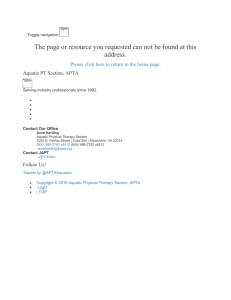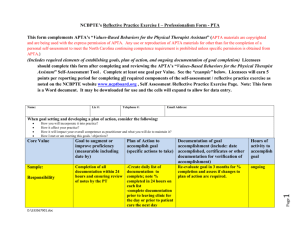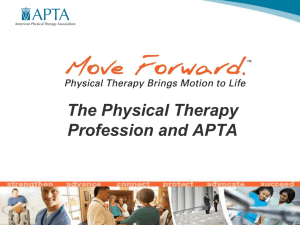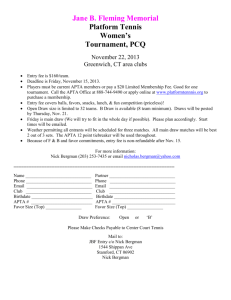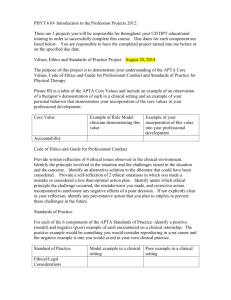Physical Therapy Treatment of a Patient with a Conversion
advertisement
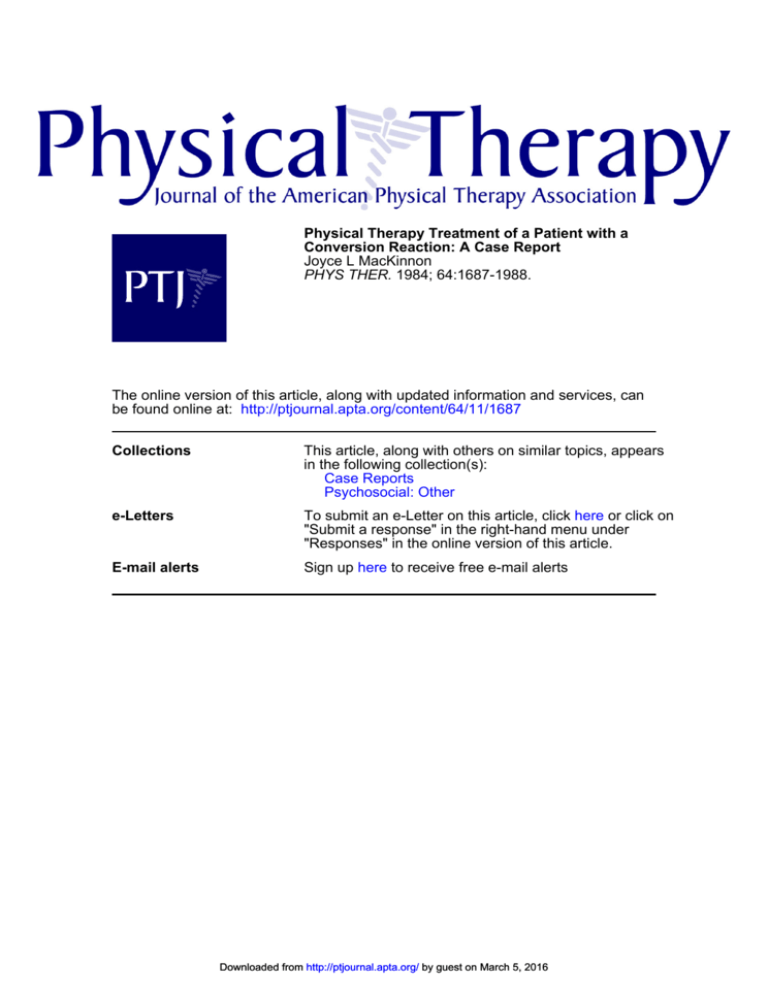
Physical Therapy Treatment of a Patient with a Conversion Reaction: A Case Report Joyce L MacKinnon PHYS THER. 1984; 64:1687-1988. The online version of this article, along with updated information and services, can be found online at: http://ptjournal.apta.org/content/64/11/1687 Collections This article, along with others on similar topics, appears in the following collection(s): Case Reports Psychosocial: Other e-Letters To submit an e-Letter on this article, click here or click on "Submit a response" in the right-hand menu under "Responses" in the online version of this article. E-mail alerts Sign up here to receive free e-mail alerts Downloaded from http://ptjournal.apta.org/ by guest on March 5, 2016 Physical Therapy Treatment of a Patient with a Conversion Reaction A Case Report JOYCE L. MACKINNON Key Words: Conversion disorder, Physical therapy. The purpose of this case study is to review the role of the physical therapist in assessing and treating a patient with a conversion reaction. Although patients with this condition comprise only a small percentage of people assessed and treated by physical therapists, we should be familiar with the conversion reaction and be prepared to treat these patients with our goal as the restoration of physical functioning. A conversion reaction occurs when psychological conflicts are represented by physical symptoms that involve parts of the body innervated by motor or sensory nerves.1 These symptoms are not under the patient's voluntary control and cannot be explained by a pathophysiological mechanism.2 Instead, the reaction of the patient is psychological in origin, is usually related in time to a particular conflict or need, and commonly appears suddenly.1,2 The primary benefit of a conversion reaction is that the symptoms permit the patient to avoid carrying out some activity and allow a compromise of internal conflict.1,2 A conversion reaction may also permit a patient to receive secondary gain from the manifestation of his symptoms, such as freedom from routine responsibilities and increased attention.1,2 The classic example of a conversion reaction is a soldier in battle who develops paralysis of the upper limb, which rentiers him unable to shoot a weapon. Conversion reactions need to be distinguished from malingering. With malingering, the patient has a conscious secondary gain in mind.3 The gain may befinancialrecompense, manipulation of others, or abrogation of responsibility. The difference between a patient who has a conversion reaction and one who is malingering is that the former is reacting on a subconscious level, but the latter is reacting on a conscious level.3,4 A person who exhibits a conversion reaction has physical symptoms that do not make physiologic sense.1 For instance, areas of numbness do not follow normal dermatome patterns, and muscle weakness may not be related to the expected nerve root involvement. Physicians need to be cautious, however, about diagnosing a patient as having a conversion reaction. This caution stems from the knowledge that some disease processes show signs of random patterns of muscle weakness and sensory loss, such as multiple sclerosis,2,4 and, therefore, a patient requires a thorough diagnostic examination and a complete case history before a definitive diagnosis of a conversion reaction can be made. Ms. MacKinnon is Coordinator of Physical Therapy, Dorothea Dix Hospital, Boylan Ave, Raleigh, NC 27611, and Assistant Professor, Division of Physical Therapy, Wing E, School of Medicine, University of North Carolina at Chapel Hill, Chapel Hill, NC 27514 (USA). This article was submitted January 9, 1984; was with the author for revision 12 weeks; and was accepted June 14, 1984. One manifestation of a conversion reaction can be paralysis. This paralysis can often be differentiated from a paralysis stemming from a physical dysfunction by noting the following features4: 1. The paralysis will often not follow a particular nerve root pattern but instead occur "just below the elbow" or "just below the knee." 2. Many times reported weakness will be more intense proximally than distally. 3. Reflexes remain normal. 4. Contractions of antagonist muscles are found when testing involved muscles. PATIENT DATA A 22-year-old white, single woman was referred to the physical therapy clinic of a state psychiatric hospital for assessment of muscle weakness of both legs. The patient said she could not move her legs and, therefore, was unable to walk. She had made a suicide attempt the week before, and she stated she had been unable to walk since the attempt. The patient demanded much attention during the initial evaluation and talked continuously during the testing procedures. The patient came to the physical therapy clinic in a wheelchair. Her legs did not demonstrate atrophy or show trophic changes. The patient demonstrated poor transfer techniques and did not want to put weight on her feet. A manual muscle test was performed on both legs, but results were inconclusive because the patient did not seem to be using her muscle strength capability. The patient did not demonstrate movements in a testing situation that she performed in an activity of daily living situation. For example, in a sitting position, she could flex her knee and hip to raise her foot up to her hands to take off her shoe. When the clinician asked her to flex at the hip in a testing situation, however, she was unable to do so. She also tightened the antagonist muscle in a testing situation. Sensory responses to pinprick did not follow a particular dermatome pattern. Achilles tendon reflexes were present and normal bilaterally. Nerve conduction testing demonstrated normal velocities, distal latencies, and amplitudes for the tibial nerves bilaterally. The patient reported no problem with her arms, and gross manual muscle testing demonstrated no weakness in the arms. These results were conveyed to the hospital's neurologist. He made the diagnosis of conversion reaction, and the patient's attending psychiatrist concurred with the diagnosis. PHYSICAL THERAPY TREATMENT The patient was treated for six weeks. The long-term goal for this patient was independent ambulation. Short-term goals Volume 64 / Number 11, November 1984 Downloaded from http://ptjournal.apta.org/ by guest on March 5, 2016 1687 were restoring active movement of legs and ambulation with an assistive device. We treated the patient as though her physical complaint of paralysis in both legs was valid. The physical therapy staff interacted with the patient in a nonjudgmental and supportive manner, focusing on physical problems and their resolution. The first week, the patient was treated five days with muscle strengthening exercises for both legs and ambulation activities. At the end of the first week, the patient performed active movement of both legs and ambulated 50 ft (15.24 m) with a walker with minimal assistance. When the physical therapist attempted to substitute a cane for a walker, however, the patient's gait pattern markedly deteriorated. She remained at a plateau for two weeks, and her treatment was reduced from five times to three times a week. At that point, the physical therapist began to treat the patient in the presence of older patients; at the end of the fourth week, the patient ambulated 100 ft (30.48 m) with moderate assistance and performed resistive exercises for both legs. Daily treatment was then resumed to capitalize on the patient's improvement. By the end of the fifth week, the patient ambulated 100 ft, with stand-by supervision, and in one more week, she ambulated independently. Her muscle strength testing grades were in the Good+ to Normal range for all muscles in both legs. She was discharged from physical therapy at that time. chair to a walker, it turned out that some of the younger patients treated at the same time had made comments to the patient about the psychogenic origin of her problem. When the patient was placed with older patients who were less judgmental, her response was more positive; she became increasingly independent in her ambulation. During the course of her physical therapy, the patient was also receiving psychiatric treatment for her depression. Physical therapy and psychiatric treatment complemented each other. Members of the disciplines shared progress reports and information but did not intrude into each other's area of expertise. SUMMARY Physical therapists are important members of the treatment team involved in the diagnosis and treatment of a patient with a conversion reaction. A physical therapist can assist a physician in making the diagnosis by performing various tests, such as manual muscle tests and nerve conduction studies, and guide the patient's return to normal physical function. This goal can be reached by the physical therapist who structures the patient's treatment by understanding that a patient suffering from a conversion reaction is not consciously aware that the problem is psychogenic in origin. REFERENCES DISCUSSION When conversion reactions are present, the patients truly believe that they have the physical symptoms they report; it does not shorten their recovery periods to tell them that their symptoms are psychogenic in origin. In the above case, for instance, when the patient plateaued in moving from a wheel- 1. Eaton MT Jr, Peterson ME, Davis JA: Psychiatry, ed 3. Flushing, NY, Medical Examination Publishing Co Inc, 1976, pp 129-130 2. Diagnostic and Statistical Manual of Mental Disorders, ed 3. Washington, DC, American Psychiatric Association, 1980, pp 244-247 3. Keim HA: Low Back Pain—Clinical Symposia. Summit, NJ, Ciba Pharmaceutical Company, 1973, vol 25, no. 3, p 24 4. Kaplan HI, Sadock BJ: Modern Synopsis of Comprehensive Textbook of Psychiatry III, ed 3. Baltimore, MD, Williams & Wilkins, 1982, pp 457-459 1688 PHYSICAL THERAPY Downloaded from http://ptjournal.apta.org/ by guest on March 5, 2016 Physical Therapy Treatment of a Patient with a Conversion Reaction: A Case Report Joyce L MacKinnon PHYS THER. 1984; 64:1687-1988. http://ptjournal.apta.org/subscriptions/ Subscription Information Permissions and Reprints http://ptjournal.apta.org/site/misc/terms.xhtml Information for Authors http://ptjournal.apta.org/site/misc/ifora.xhtml Downloaded from http://ptjournal.apta.org/ by guest on March 5, 2016
